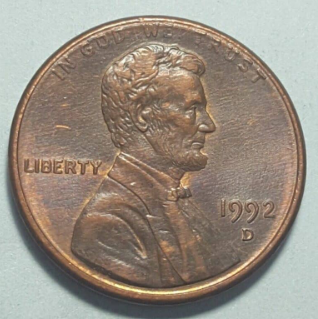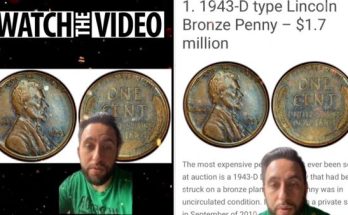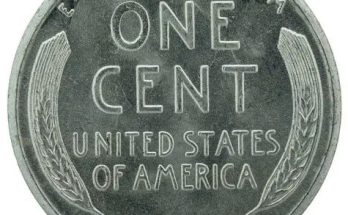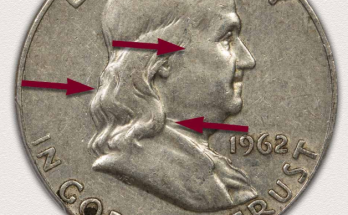The 1992 penny is a common circulating coin that was minted in large quantities, making it relatively easy to find in circulation or collections. Regardless of its widespread availability, the value of a 1992 penny varies based on its variation as it has two variations, its condition, rarity, and other variables.
Table of Contents
In this article, we will look closely at the 1992 penny and consider why it is a worthy addition to any collection.
1992 Penny Details
The 1992 penny is a one-cent coin issued by the United States Mint in 1992. The obverse (front) side of the coin depicts Abraham Lincoln, the 16th President of the United States, while the reverse (back) side depicts the Lincoln Memorial. It is a Lincoln Memorial coin designed by Victor D. Brenner (obverse) and Frank Gasparro (reverse).
The 1992 penny has a round shape with a plain edge and is composed of 97.5% zinc and 2.5% copper, unlike earlier pennies that were made of solid copper. The coin weighs 2.5 grams and has a diameter of 19.5 millimeters and a thickness of 1.55 millimeters.
With a high mintage of 9,101,754,860 pennies, the 1992 penny is still in circulation today and has a face value of one cent
1992 Penny Value Chart
| Mint | Good | Fine | Extra Fine | Uncirculated |
| 1992 No Mint Mark Lincoln Penny Value | $0.15 | $0.33 | $2 | $5 |
| 1992 – D Lincoln Penny Value | $0.15 | $0.33 | $0.5 | $1 |
| 1992 – S Lincoln Penny Value | $0.2 | – | $0.7 | $1.5 |
1992 No Mint Mark Lincoln Penny Value

The 1992 penny with no mint mark was produced in large quantities, with over 4.6 billion pennies in the Philadelphia mint. While these coins aren’t especially rare, it’s very much valuable to collectors and enthusiasts.
As with all coins, the condition of the 1992 penny is a key factor in determining its value. Coins in mint condition or that have not been circulated are usually more valuable than those that have been circulated. Even circulated coins, if in excellent condition, can be valuable. While these coins are not particularly rare, some variations can make them more valuable. Some 1992 S pennies, for example, have some flaws such as doubled dies or other minting errors That can increase their value to collectors.
In general, a 1992 penny in average circulated condition with no mint mark is valued at about one cent. If the coin is in exceptional condition or has a rare error, it could be worth much more.
Even though they are only 20 years old, only rare pennies are deemed highly valuable due to their exceptional condition. With only those graded as MS 69 are considered to be worth a substantial amount of money. These rare pennies can command a price of around $1,000 or more.
1992 – D Lincoln Penny Value
Despite not being particularly rare, the 1992 D mark penny does have some worth to coin collectors. In 1992, the Denver Mint minted 1992 pennies in 4,448,673,300 instances. Because they were produced in large quantities, they are quite common, hence they do not command a high value. Uncirculated examples, however, can range in value from $0.10 to $25.
Only samples with an MS 69 grade are an exception. In rare instances, when such pieces turn up on the coin market, collectors spend around $2,750 for them. The most expensive is a 1992 Memorial penny in an MS 65 grade, which cost $14,100 in 2014 at an auction.
1992 – S (Proof) Lincoln Penny Value

In 1992, the San Francisco Mint produced only Memorial penny proofs with the “S” mint mark, which indicates that they were struck at the San Francisco Mint. The coins are part of the Memorial penny collection, which was launched in 1959 to mark the 150th anniversary of the birth of Abraham Lincoln.
Proof pennies are struck with greater care and attention to detail than circulation pennies. They are created with highly polished dies and planchets, which are blank metal disks used to create the coin. As a result, the coin has a more lustrous finish and a sharper design. The “S” mint mark is found below the year on the obverse, which is located below the year.
The 1992 S-proof penny had a high mintage of 4,176,560 pieces. While this proof coin has a higher mintage than some other proof coins, it is still deemed a limited edition coin. This is because proof coins are not produced for circulation and are only accessible through limited channels, such as the United States Mint’s annual proof set.
A 1992 S-proof penny’s value can vary based on several factors, including its condition, rarity, and historical significance. Coins that are in better condition and have fewer defects are generally worth more than those in worse condition. Furthermore, coins with unusual or rare variants may be worth more than those with more common variations.
Depending on the condition, one of the flawlessly preserved samples costs only $0.50 to $5. In 2003, a stunning DCAM (Deep Cameo) specimen with a remarkable PR (Proof) 70 rating was purchased for a substantial amount of $1,380. DCAM specimens were valued highly due to their exceptional quality, reflected in their high PR 70 rating, despite the lower average cost.
History of the 1992 Lincoln Penny
The 1992 penny is a modern coin that is often overlooked by collectors due to its low value. However, this penny is a part of history and worth every attention.
The Lincoln Memorial penny was first issued in 1959 to honor Abraham Lincoln’s 150th birthday. The back of the penny has been redesigned to depict the Lincoln Memorial in Washington D.C. The portrait of Abraham Lincoln, the 16th President of the United States, appears on the obverse of the penny.
The Lincoln Memorial penny was minted for nearly 50 years, from 1959 to 2008, and many distinct varieties were produced during that period. The 1992 penny is a part of this modern series. The design of the coin stayed consistent throughout the series, but the Mint made several changes to the penny’s composition during this period. The 1992 penny was made of copper-plated zinc and it was used from 1982 to 2008.
The 1992 penny is not particularly valuable, despite its significance as part of the Lincoln Memorial penny series. The majority of the coins in the series, including the 1992 penny, are widely accessible on the market and are only worth a few cents. However, the coins in the series are still sought after by collectors and history buffs as a part of American history.
Whether you want to sell your coins, you’ll get a good price through our certified platform.
The Lincoln Memorial penny series is popular among collectors because U.S. laws shield these coins from being melted down. This means that the coins are still readily available on the market, and collectors can easily add them to their collections. Furthermore, the coins in the series have historical importance because they commemorate the life and legacy of Abraham Lincoln, one of the most beloved and influential Presidents in American history.
The Lincoln cent is one of the most well-known American coins produced to honor a significant figure in American history. Over a century of minting, it has remarkably remained unchanged, but redesigning the reverse was a means to honor significant events.
1992 Lincoln Penny Grading
Knowing the grade and value of a 1992 penny can be a complex process, as it requires evaluating various factors such as wear, strike quality, luster, and general condition. While professional grading companies offer reliable grading services, they can be expensive and may not be necessary for all coins.
The grade of a coin ranges from 1 to 70, with 70 denoting an ideal, uncirculated coin. A coin with a grade of 1, for example, is heavily used and may have substantial damage, whereas a coin with a grade of 70 is flawless and has never been used. Remember to handle your coins carefully and store them in a safe, dry place to preserve their condition and value for years to come.
Curious about the worth of your 1992 penny? Watch this.
Rare 1992 Lincoln Penny Error Lists
There are two common varieties and a few standard errors on the 1992 Lincoln cent that can raise their worth. Errors typically result from either technical or human error. Continued use of the equipment may cause some components to become loose and others to wear out. As a result of this, some coins won’t receive the necessary strike. Let’s examine some of these errors in this section.
1. 1992 Close and Wide AM Varieties

In 1992, the US Mint produced two different varieties of the Lincoln Memorial Cent, which collectors have come to recognize as the “Wide AM” and Close AM” varieties.
The first variety, commonly referred to as Wide AM, features the letters AM widely and evenly spaced apart. The second variety, known as Close AM, shows the letters AM much closer together, almost touching each other. The Close AM variety is much rare than the Wide AM, and therefore, it is highly sought after by collectors.
Another notable difference between the two varieties is that the designer’s initials, FG, are positioned more closely to the foot of the Lincoln Memorial on the coins with the Wide AM than they are on those with the Close AM. Dies used to strike the Wide AM variety had a wider gap between the A and M in AMERICA, resulting in more widely spaced letters. The Close AM variety was created using a different process in the letters being closer together. This variation was likely due to the use of a different hub for creating the die.
In both mints that produce pennies from the regular strikes, there is a small AM difference among the coins. However, red pennies with close AM in an MS 67 grade are the most expensive and valuable of the two, valued at thousands of dollars. For such a piece, you might be paying $20,000 minimum.
2. 1992 Strike-through Penny Error

This error occurs when debris becomes lodged between the planchet and the die during the striking process, leaving a distinct mark on the coin’s surface. While not rare, these coins are fascinating pieces and serve as a reminder of the imperfections that can occur in even the most carefully crafted coins.
3. 1992 Lincoln Penny Double Denomination Error

When two different currency denominations are struck on the same coin, it is known as a double denomination error. For instance, a coin with both penny and dime details will be produced when a penny is struck on a dime.
The coin that results from this mistake is typically more expensive. For instance, a crimson 1992 penny struck on a dime graded PCGS MS 64 can fetch over $2,600.
4. 1992 Lincoln Penny Obverse Die Cap Error

This error occurs during the production process, and it happens when the coin gets trapped in the die.
As a result, the cap gets struck on the next planchet, thereby making the image of the cap reflect on the coin.
This type of error is relatively rare, as it’s not usually minted in many quantities. The value of this error coin will largely depend on the severity. Coins that exhibit a complete image transfer are worth more than those with a partial transfer. The value of a 1992 penny with the die cap error is about $300.
Whether you want to sell your coins, you’ll get a good price through our certified platform.
Interested in more 1992 penny errors? Watch this video.
1992 Lincoln Penny FAQs
1. What Variant Of The 1992 Penny Is Worth A Small Fortune?
The majority of 1992 pennies don’t worth above face value, but those with flaws are precious. The coins with the close AM mistake are very valuable, as they are worth over $25,000
2. Is The 1992 Penny Rare?
No, the 1992 penny is not considered rare. Over 9 billion were produced by the United States in 1992.



